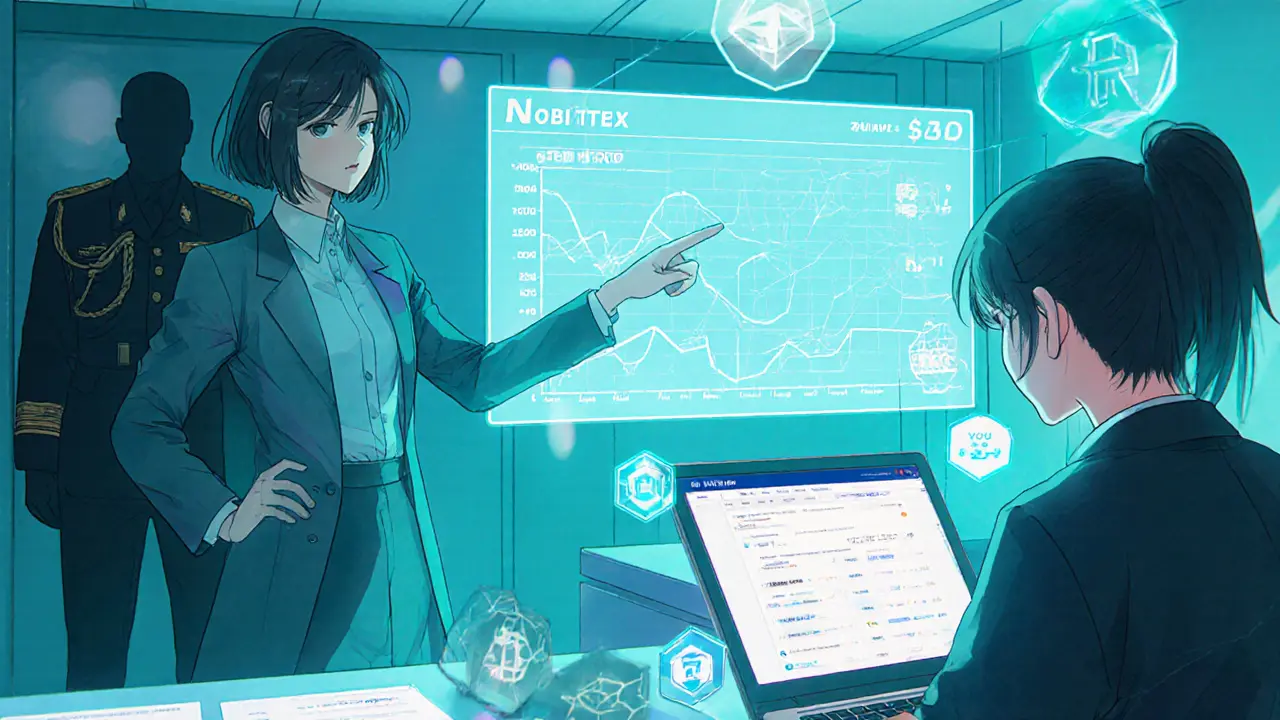How Iran’s Crypto Adoption Thrives Under Sanctions

Iran Crypto Adoption Impact Calculator
Impact Analysis Results
Adoption Resilience
Based on current trends and user behavior
Strong
Economic Impact
Potential revenue generation for individuals
Moderate
Regulatory Compliance
Government monitoring effectiveness
Moderate
Technology Adaptation
Use of Polygon and cross-chain solutions
High
When we talk about Iranian cryptocurrency ecosystem is the network of exchanges, miners, regulators, and users that handle digital assets inside Iran despite international sanctions, the first thing that pops up is sheer resilience. Since the 2017 sanctions cut off Iran from mainstream banking, digital money turned from a novelty into a lifeline. In the next few minutes you’ll see why crypto adoption in Iran isn’t a fringe hobby-it’s a survival strategy, a revenue stream, and, for the government, a way to keep an eye on capital flows.
Quick Takeaways
- Iran moved over $3.7billion of crypto through Jan‑Jul2025, even after an 11% dip caused by tighter enforcement.
- Domestic exchange Nobitex handles most retail trades; the IRGC funds many of its high‑volume wallets.
- The Central Bank of Iran (CBI) blocks and then selectively re‑opens crypto‑to‑fiat APIs to monitor user data.
- Users dodge restrictions with VPNs, stablecoins (USDT → DAI), and the low‑cost Polygon network.
- New tax law (Aug2025) treats crypto gains like gold or forex, signaling long‑term tolerance.
Why Sanctions Made Crypto Attractive
International sanctions crippled Iran’s access to SWIFT and other correspondent banks. Without a way to move dollars abroad, businesses and families faced a cash‑flow dead‑end. Crypto solves three problems at once:
- Borderless transfer: Bitcoin and stablecoins cross borders with a single seed phrase.
- Self‑custody: Users keep assets in hardware wallets, out of government reach.
- Speed: Transactions settle in minutes, not days.
These traits echo what Chainalysis calls “crisis‑driven adoption” - a pattern also seen in war‑torn economies.
Key Players Shaping the Landscape
Understanding who’s pulling the strings helps demystify the whole system.
- Nobitex - Iran’s largest domestic exchange. It offers fiat‑to‑crypto pairing, requires users to register with national ID, and reports every trade to the CBI via a government‑run API.
- Islamic Revolutionary Guard Corps (IRGC) - According to U.S. Treasury reports, the IRGC routes procurement funds through Nobitex wallets, turning crypto into a core settlement layer for sanctioned purchases.
- Central Bank of Iran (CBI) - In December2024 it shut down all web‑based crypto‑to‑rial converters, then reopened a limited gateway in January2025 that forces exchanges to share user transaction data.
- Tether (USDT) - The most popular stablecoin for Iranian traders until July2025, when the company froze 42 Iranian‑linked addresses, prompting a rapid shift to DAI.
- DAI - A decentralized stablecoin that survived the USDT crackdown because it lives on multiple L2 chains.
- Polygon network - Chosen for its cheap, fast transactions; Iranians migrated USDT holdings to DAI on Polygon after the Tether freeze.
- TRM Labs - Provides blockchain intelligence that identified the typical Iran‑centric transaction flow: fiat → USDT → layered wallets → off‑ramp.

How the Government Regulates While Keeping the Tap Open
Iran’s approach feels like a tug‑of‑war between control and necessity.
- **Licensing** - Mining was legalized in 2019, but licensed miners must sell every block to the CBI at a state‑set price. The high tariff on electricity pushes many miners underground.
- **Exchange supervision** - Domestic platforms must integrate CBI APIs that expose user IDs and transaction timestamps. The goal is surveillance, not outright ban.
- **Taxation** - The August2025 “Law on Taxation of Speculation and Profiteering” levies capital‑gains tax on crypto trades, putting digital assets in the same bracket as gold.
- **Selective freezes** - When OFAC and Tether target Iranian addresses, the CBI quickly issues public advisories urging users to move to DAI, showing a willingness to adapt rather than crush the market.
This hybrid model mirrors what TRM Labs calls “controlled liberalization”: the state tolerates crypto as long as it can monitor the flow.
How Everyday Iranians Keep Their Crypto Flowing
Most Iranians treat crypto like a second bank account.
- **VPNs and proxy tools** - A 2025 Reddit poll showed 78% of respondents use VPNs daily to reach foreign exchanges like Binance or KuCoin.
- **Stablecoin swaps** - After the July2025 Tether freeze, community guides on Telegram explained step‑by‑step how to swap USDT for DAI on Polygon via decentralized exchanges such as QuickSwap.
- **Cross‑chain bridges** - Users favor the Polygon Bridge because it costs <$0.02 per transaction, far cheaper than Ethereum’s $5‑$10 fees.
- **Peer‑to‑peer (P2P) marketplaces** - Platforms like LocalBitcoins still operate, allowing cash‑in‑person deals that bypass digital checkpoints.
The result? Even as total flows fell 11% in the first seven months of 2025, demand stayed high, and volume shifted from USDT to DAI, then to Bitcoin for longer‑term storage.
Comparing Stablecoins Used in Iran (2024‑2025)
| Stablecoin | Main Network | Avg. Transaction Cost (USD) | Typical Use Case |
|---|---|---|---|
| USDT | Ethereum (ERC‑20) & Tron (TRC‑20) | $5‑$10 (Ethereum) / $0.10 (Tron) | Liquidity for quick fiat conversion on Nobitex |
| DAI | Polygon (L2) | $0.02‑$0.05 | Post‑freeze safe haven; easy bridge to Ethereum |
| USDC | Solana & Polygon | $0.01‑$0.03 | Secondary option when USDT is restricted |
Notice how the cheapest network (Polygon) became the go‑to after enforcement actions. The table also shows why USDT remained popular despite higher fees: it was the most widely accepted stablecoin on domestic exchanges.
Future Outlook: Will Crypto Remain Iran’s Financial Backbone?
Two forces will shape the next wave.
- **International enforcement** - OFAC’s 2025 designations now include wallet addresses, making every on‑chain move a potential legal trigger. Expect more freezes, especially targeting high‑volume exchange wallets.
- **Domestic policy shifts** - The CBI’s recent API rollout suggests Tehran wants granular data for future tax collection and possibly for converting crypto revenues into hard‑currency reserves.
If sanctions tighten further, we’ll likely see a deeper migration to decentralized, low‑cost chains (Polygon, Arbitrum) and an uptick in hardware‑wallet sales. If the government relaxes its tax regime or offers incentives for licensed miners, formal mining could rebound, but the high energy tariff remains a wall.
One thing is clear: as long as traditional banking stays blocked, crypto will stay the most viable financial outlet for millions of Iranians.

Frequently Asked Questions
How much crypto did Iran move in 2025?
From January to July2025, Iranian crypto flows topped roughly $3.7billion, an 11% drop compared with the same period in 2024, mainly due to tighter sanctions enforcement.
Why did Iranian users switch from USDT to DAI?
Tether froze 42 Iran‑linked wallets in July2025. Community guides advised swapping USDT for DAI on Polygon because DAI is decentralized and Polygon offers sub‑cent transaction fees, keeping funds liquid while avoiding frozen addresses.
Is mining still legal in Iran?
Yes. The 2019 law legalised mining, but only licensed operations can sell mined coins directly to the Central Bank and must pay high electricity tariffs. Many miners operate underground to avoid those costs.
What role does the IRGC play in crypto transactions?
U.S. Treasury analysts say the IRGC uses crypto-mainly through high‑volume wallets on Nobitex-to settle procurement of sanctioned goods, turning digital assets into a core financial conduit for the militia.
How does the new tax law affect crypto traders?
The August2025 law treats crypto gains like gold or forex. Traders must report profits and pay a capital‑gains tax, which the CBI can track thanks to the mandatory API reporting by domestic exchanges.
Marie-Pier Horth
Behold, the empire of sanctions crumbles before the relentless tide of crypto, and Iran rises like a phoenix from the ashes. The digital gold flows through shadowy alleys, turning hardship into opportunity. Even the most rigid regulators can’t halt a wave that has already begun to reshape the economy.
Gregg Woodhouse
lol the whole thing is just a meme for them.
F Yong
Oh sure, let’s all pretend that crypto isn’t just the latest front for a hidden elite to bypass sanctions. The data points are there, you just have to connect the dots yourself. Meanwhile, the rest of the world watches the spectacle and wonders why everyone’s talking about digital tokens.
Sara Jane Breault
Great stuff, keep it up! The community really needs this kind of clear, helpful info about how people are adapting together.
WILMAR MURIEL
Reading through this, one can’t help but notice how resilient human ingenuity truly is, especially when faced with external pressures that aim to limit financial freedom. The sanctions, while severe on paper, have inadvertently spurred a wave of innovation that ripples across the Iranian tech ecosystem. People have turned to decentralized finance as a lifeline, circumventing traditional banking limitations that were once considered unbreakable. This pivot to crypto isn’t merely a reactive measure; it reflects a deeper cultural shift toward embracing borderless finance. When you examine transaction volumes, the numbers speak volumes about a populace unwilling to be shackled. Even modest users have migrated to stablecoins like USDT, finding a semblance of stability amidst economic turbulence. The regulatory landscape, though strict, appears to be evolving, with authorities attempting to monitor rather than outright ban digital assets. That push-pull dynamic creates an environment where technology adoption accelerates, as developers race to provide compliant yet flexible solutions. Polygon’s layer‑2 scaling, for instance, offers low‑cost transactions that are crucial for a market sensitive to fees. Cross‑chain bridges further widen the options, allowing users to move value without relying on centralized exchanges that could be targeted. The social aspect, too, cannot be ignored: community forums, local meet‑ups, and online tutorials have sprung up, fostering knowledge sharing that demystifies crypto for the average citizen. In many ways, the sanctions have acted like a catalyst, forcing an otherwise sluggish financial sector into rapid digital transformation. This is reminiscent of historical periods where external pressures sparked internal innovation, think of wartime tech leaps. The moderate economic impact observed may be just the tip of the iceberg; as more participants join the ecosystem, the ripple effects could expand into ancillary industries like fintech services, legal consultancy, and even education. Moreover, the appetite for decentralized solutions could spill over into other sectors, prompting a broader re‑evaluation of governance structures. Ultimately, the resilience shown by the Iranian crypto community underscores a universal truth: when faced with constraints, creativity finds a way to thrive, often in the most unexpected corners of technology.
Kristen Rws
Love the optimism here! Even with tiny typos the message shines bright.
Fionnbharr Davies
It’s fascinating to see how a community can self‑organize around decentralized tools, especially when traditional avenues are constrained. The data suggests a balanced growth that could serve as a model for other regions facing similar pressures.
Darrin Budzak
Honestly, the numbers just show that people adapt when they need to. Nothing too wild, just a steady shift toward more accessible finance.